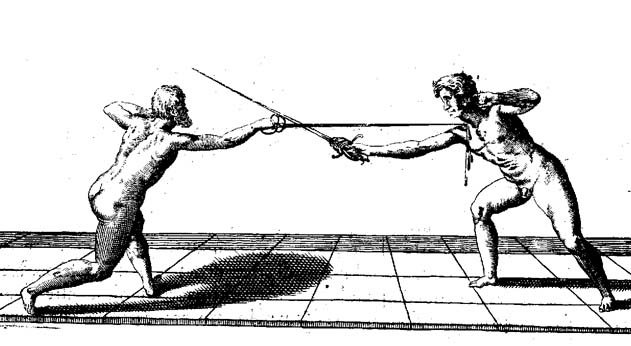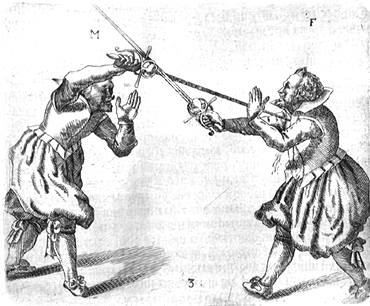|
|
Post by Anders on Sept 3, 2012 16:11:02 GMT
Hey, it's better than Katana vs Longsword.  Suppose you have a swordsman with a long, deeply curved sword like a Hussar saber or a shamshir. He's fighting a swordsman with a relatively short rapier, say the A&A Serenissima or Del Tin 16th Century Italian (Meaning both swords have at least roughly similar reach.) What could one expect from such a duel? I'm not exactly asking who would win, since I assume that comes down to individual skill. Rather, I'm curious at what sort of problems the fighters would have to deal with in facing a sword so different from his own. |
|
|
|
Post by John P on Sept 3, 2012 21:55:50 GMT
I would expect that the rapier fencer would try to stay just out of range and try to sing in with a high thrust trying to intercept the cut with the guard    I think that the saber fighter is going to try you set up 2 time exchanges and use beats to get past the point. I'l try to get some video of my group playing with mixing rapiers and sabers next Saturday. |
|
Kuya
Registered
Posts: 1,396
|
Post by Kuya on Sept 3, 2012 23:08:14 GMT
Rapier.
|
|
Razor
Senior Forumite
Posts: 1,883 
|
Post by Razor on Sept 3, 2012 23:34:25 GMT
It would be pretty much the same as cut & thrust vs. rapier and saber vs. small sword. And this is why you see the broadsword and saber fighters adopt a linner stance as you see with the rapier and small sword stance, starting in the 17th century with the rapier and really seeing it in the 18th century with the fast and deadly small sword.
The saber fighter would have to move the rapier's point away from him and move in close to hit the rapier fighter. If the saber fighter don't mve the rapier's point away and just attacks at him, it would pretty much look like the pics that John posted.
The rapier fighter would have to have his sword not found by the saber fighter and would have to do feints and cavazione and watch out for the saber fighters moulinets.
|
|
|
|
Post by Bogus on Sept 5, 2012 2:01:48 GMT
Ah, now this is my kind of fight!  To continue what has mostly already been said, the rapier will hold back looking for an opening while the saber will attack the opposing sword to try and get it out of the way. Rapiers are fast and designed for linear fighting, but they lack heft so are unlikely to push a saber out of the way. A saber, meanwhile, can thrust but not very well so the best bet is going to be to knock open the rapier's defense and go for a quick strike. If it's a dirty fight he could try to grab the rapier too as they're somewhat vulnerable to that (moreso than saber anyway). |
|
|
|
Post by Ceebs on Sept 5, 2012 5:16:45 GMT
I'd say it was utterly dependent on the competence and skill of both wielders and whether they had any experience fighting against the other weapon.
|
|
Deleted
Deleted Member
Posts: 0
|
Post by Deleted on Sept 5, 2012 16:17:23 GMT
That's a boring cheap copout answer. Please play fair in this thread!
I'm guessing on equal terms the saber is probably slightly disadantaged as the rapier is more a duelling weapon while the saber generally more a war weapon.
|
|
|
|
Post by Lukas MG (chenessfan) on Sept 5, 2012 17:29:06 GMT
It just so happens that this "boring copout answer" is the only truly correct one. You can argue blades and designs all day long but it matters NOTHING compared to the opponents' skills. So yeah, it is boring but it's the truth.
|
|
Taran
Member
Posts: 2,621
|
Post by Taran on Sept 5, 2012 19:40:17 GMT
You forgot the effects of luck on the fight. Or Providence. Even the best fighter may be felled by the worst if he slips on a wet or icy spot or his shoes come untied at the wrong time. Or maybe he is sick, or is recovering from illness or injury.
|
|
|
|
Post by Anders on Sept 5, 2012 19:52:09 GMT
I was under the impression that sabers do in fact thrust rather efficiently, and that curved swords actually have an advantage in that they can thrust around the opponent's guard.
I was actually more interested in the process than in the outcome.
Likewise, this is rather irrelevant.
|
|
|
|
Post by Ceebs on Sept 6, 2012 5:08:09 GMT
So are you actually asking if either weapon has an innate advantage over the other? Unfortunately the problem with weapon "vs" threads is that ultimately the weapons themselves are secondary to the skill and competence of those that wield them.
What Cheness, Taran, and myself are alluding to is that these weapons have people behind them, and unless they are factored in to the equation then you will not receive an informative answer.
|
|
Deleted
Deleted Member
Posts: 0
|
Post by Deleted on Sept 6, 2012 16:24:12 GMT
Too bad there weren't any anal statisticians around to collect data on duelling during that era. A good statistical population would kill some of the speculation.
|
|
|
|
Post by Elheru Aran on Sept 6, 2012 16:36:34 GMT
To be quite honest it wouldn't really help. Sabers are most distinctively used around the 1700-1800's, while the rapier's heyday was the late 1500-early 1600's. There is no recorded duel, IIRC, where the two weapons went up against each other; normally the rule was that both duellists would use similar, if not identical, weapons.
Best way to get data on this would be to have some people in HEMA give it a try...
|
|
Taran
Member
Posts: 2,621
|
Post by Taran on Sept 6, 2012 19:15:35 GMT
Yeah. Not so much. The ones that are curved enough to pull that off in the way you suggest don't thrust worth a dang.
And any weapon that can thrust can thrust around any guard. I have a nasty tendency to turn what the SCA calls a "wrap" shot into a thrust into my opponent's back. While standing in front of him. With a straight blade.
It all depends on where the pivot point is. But if the Blade, itself, is the pivot point, then the point will turn during the thrust and cause the thrust to become a pushed slash, shallower and without the penetration or power of a traditional sabre cut.
|
|
|
|
Post by Elheru Aran on Sept 6, 2012 20:00:26 GMT
Thrusting with a highly curved saber is actually not a bad move when you're in the saber's natural element, horseback. There, the curve comes into play-- you ride toward a foot-soldier, you hook the tip up into them, and as you ride past the curve helps to naturally pull the tip of the blade up and out of the target. More likely to be lethal than a cut and doable at high speed if you're a good rider.
Of course, the people that used these were almost always good riders and experienced warriors (Hussars and Ottomans)...
|
|
|
|
Post by Anders on Sept 6, 2012 21:14:41 GMT
Not quite. I'm asking: What approach would a saber fencer need to assume when fighting a rapier fencer and vice versa, and what difficulties would either fighter be facing? What would be most troublesome about facing a rapier with a curved sword and what would be most troublesome about facing a curved sword with a rapier? Perhaps, but a straight sword can only thrust in a linear fashion, while a curved sword can thrust in a curved line. Here's basically what I'm talking about. (Should start at the 5:18 mark.) You're talking about this?That's not really a "thrust" at all, though. Plus, I don't think it would be very efficient with a rapier. |
|
Taran
Member
Posts: 2,621
|
Post by Taran on Sept 6, 2012 21:20:38 GMT
No. I'm talking about turning that into a thrust.
|
|
|
|
Post by K. Vander Linde on Sept 6, 2012 22:29:50 GMT
Normaly I would agree with you on that but there are recorded "duels" of saber vs. rapier in western Russia. I put duels in "" because it is more of a street fight than a duel of honor. In the most famous case the man useing a rapier killed the saber user with the "kiss of death", they exagrated this in the film 1612 by adding fantisy to real historic events, the "kiss of death" is what happens when (as in the Photos of rapier play by Cappo Ferro)the blade of the rapier enters the head through the mouth and exits out the back of the skull.
Ultimatly though it boils down to skill of the users.
However if I was to bet, given that the fighters had the same amount of time & experience with the weapons, I'd put my money on the Rapier, unless that time/experience is very small, then saber.
|
|
|
|
Post by Dave Kelly on Sept 6, 2012 22:53:34 GMT
From a purist standpoint I think the primary concerns are the differences in weights of the two weapons. Rapiers well into their last period would run 2.75 lbs. There wasn't a lot of emphasis on defensive counter movements. The saber tended to be in the 2.25 lb or less category with a lot of movement.
The rapier will try to keep the adversary in front and at distance. The saberman will try to get inside the point where multiple strokes are possible far more quickly than the other fighter can respond.
Skill and use of the left hand is a big factor in earlier combats also. Weapons use and physical dexterity and speed also come into play. The point weapon has a slight edge statistically...take your pick. Saber is my weapon. :mrgreen:
|
|
|
|
Post by K. Vander Linde on Sept 7, 2012 1:23:47 GMT
Personaly I would pick the saber too. Grewup with sabers, studied rapiers, fought with both. The reason I would go with the saber over the rapier is quite simple, with a saber you can preforme single and double counters. If you try a double with a rapier and the other person Knows what their doing your dead. Thats one of the reasons the rapier went out of favor, to long of a blade for parries. (in the baroque definition of the word). Now my earlier post might seem in favor of the rapier. Thats because I'm experienced in fighting with the rapier & saber against many combinations of weapons...longsword, poleaxe, sidesword &buckler,etc. In that experience I understand the rapier from tip to peen,an so I know its short comings all to well and have the bruses to prove it. Same with the saber, still have a hole in my right leg from trying to dead parry a murderstroke  bad idea. Saber is over all faster in the cut, rapier faster in the thrust. An let's face it I see it when watching people spar all the time, when people get tired they start swinging. swing a rapier you lose swing a saber and win. |
|

